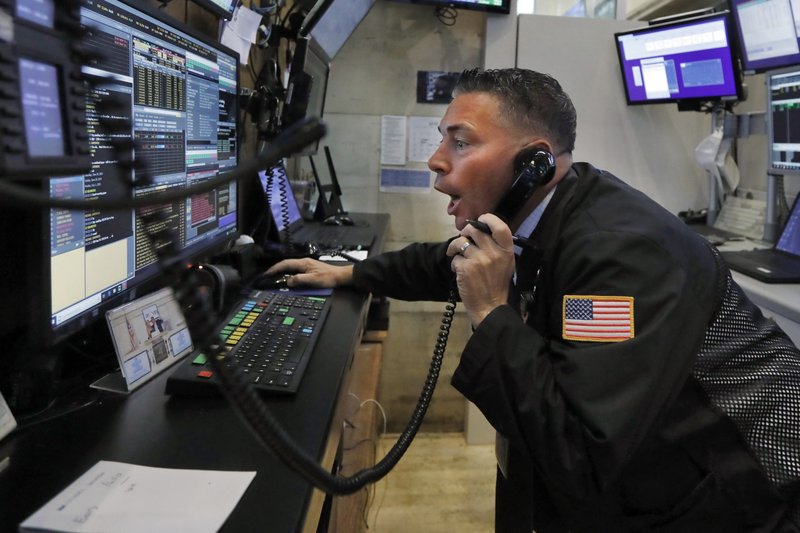Wall Street applauded a cease-fire in the U.S. trade war with China and started July with a bang.
The S&P 500 index was on track for a record high and the Dow Jones Industrial Average gained more than 130 points in midday trading Monday. Investors snapped up riskier holdings as the world’s two biggest economies agreed to continue trade talks. The U.S. agreed to hold off on imposing new tariffs on $300 billion in Chinese goods, although existing tariffs on $250 billion of imports remain in place.
Technology stocks and banks led the gains. Traders turned their backs on more defensive holdings, pushing bond and gold prices lower. Utilities lagged the market in another sign that Wall Street had a bigger appetite for risk.
Chipmakers rallied on plans by the U.S. to loosen some sales restrictions to Chinese telecommunications company Huawei. Broadcom rose 4.2% and Nvidia rose 2.2%. Technology giants Apple and Microsoft also helped lead gains.
Banks helped lead the broader market higher. Bank of America rose 1.6% and JPMorgan Chase gained 1.5%. Consumer product makers and other consumer companies also moved higher. Many of those companies, including Nike, have much to gain or lose in the ongoing trade dispute.
Oil prices rose and pushed energy stocks higher as OPEC considers extending production cuts.
Wall Street just finished its best month since January and that helped push the S&P 500 index to a 3.8% second quarter gain. The index is now up more than 18% heading into the second half of 2019.
The gains in the first half of the year were marked by months of volatile trading as investors rode the ups and downs of the trade war. That volatility is unlikely to fade as the U.S. and China head into yet another round of trade talks.
The market had a similar bounce back in December when both sides agreed to more talks and negotiations seemed on track. But that rally quickly faded as investors complained the agreement didn’t resolve the core issues in the dispute.
The key difference this time around is the Federal Reserve. In December, the Fed spooked investors by raising interest rates for the seventh time in two years. Now, the central bank has said it is willing to cut rates in order to shore up the U.S. economy if the trade war crimps growth in what is now the longest economic expansion in U.S. history.
KEEPING SCORE: The S&P 500 index rose 0.7% as of 11:50 a.m. Eastern time. The Dow Jones Industrial Average rose 132 points, or 0.5%, to 26,732. The Nasdaq composite rose 1.1%.
OVERSEAS: The truce between the U.S. and China, along with some upbeat economic data, helped push global shares higher.
Japan’s benchmark Nikkei 225 added 2.1% to finish at 21,729.97. Hong Kong’s markets were closed for a holiday. The Shanghai Composite rose 2.2% to 3,044.90.
European markets rose broadly. The unemployment rate in the 19 European Union countries that use the euro fell to its lowest in more than a decade in May.
SOLID WYNN: Casino operator Wynn Resorts rose 6.8% after Macau officials reported a 5.9% boost in gambling revenue.
The company has significant operations in the southern Chinese gambling haven. It gets about 75% of its revenue from Macau, according to FactSet data.
CHIPPED POLISH: Beauty products company Coty plunged 14.5% after telling its investors that it will write down $3 billion worth of brands.
The brands were bought from Procter & Gamble in 2016. The company expects the restructuring program to cost it about $600 million through 2023.
PRIVATE TRACKS: Railroad operator Genesee & Wyoming rose 8.7% after it agreed to sell itself to Brookfield Infrastructure and GIC.
The company, which owns 120 short line railroads, is being taken private in a deal valued at about $6.37 billion. Most of its operations are in North America.
CRUDE MEASURES: Rising oil prices gave energy companies a jolt as OPEC considers extending a deal to cut production.
Oil prices rose 2.3%. That helped push ConocoPhillips shares 1.9% higher and Halliburton’s stock 2.6% higher.
The oil cartel faces weakening demand as global economic growth slows. The current deal to cut production is meant to help reduce oversupply and push prices higher.
(AP)











